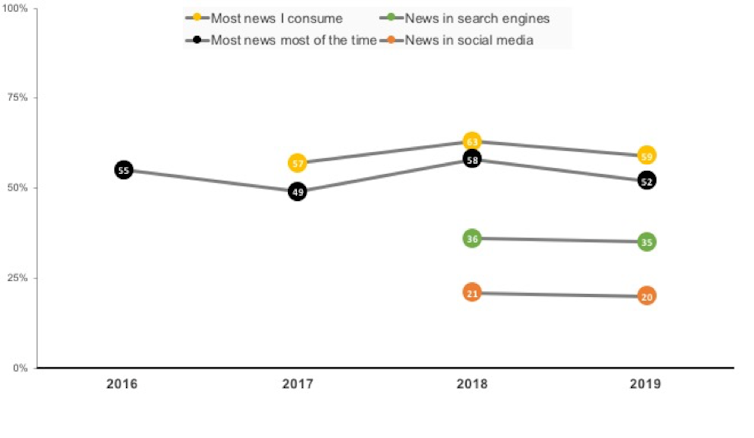By Colette Brin, Université Laval and Rasmus Kleis Nielsen, University of Oxford
Attitudes towards news media and consumption behaviour in Canada pose a sort of conundrum. In general, Canadians have a positive view of journalism and relatively high trust in media, but on the other hand, they are little inclined to pay for digital news sources.
According to the new 2019 Digital News Report, a survey conducted in 38 countries by the Reuters Institute for the Study of Journalism at Oxford University, only nine per cent of Canadian respondents say they’ve paid for online news in some way or another in the past year (digital subscription, one-off payment or purchase of a news app).
Even fewer respondents, barely one per cent of our sample, made a donation to a media organization in the 12 months prior to the survey. This is not surprising, as non-profit news outlets that solicit donations from readers are still a rarity in the Canadian media landscape. And if people are unwilling to pay for news online, it is likely because free content is abundant.
These findings raise questions about the potential impact of federal tax incentives for subscriptions and donations to online news. Both measures, supplemented by a refundable labour tax credit, are meant to sustain journalism in the highly competitive digital environment.
Newspapers are struggling to develop new funding models to compensate for a 60 per cent decline in advertising revenue, with most ad money now going to large digital platforms. Will we see more paywalls and non-profit structures in the coming years, and will Canadians contribute more substantially to news as a result?
Younger news consumers more likely to pay
The survey suggests that the effect will be modest at first, but there is some potential for future growth.
That’s because younger respondents are twice as likely to have paid for online news (18-34: 14 per cent; 35 and over: seven per cent). And more men (12 per cent) than women (six per cent) have paid for news.
But even though one in five respondents who had not paid for news stated in the 2018 Digital News Report that they would consider doing so in the coming year, the percentage of those who did pay (nine per cent) remains identical in this year’s survey.
And when asked if they had to choose a single form of paid online content, respondents were more likely to prioritize entertainment over news: 40 per cent would select a video service like Netflix, 10 per cent a music service like Spotify and only nine per cent would pick an online news subscription (only four per cent for Canadians aged 18-34).
Trust and satisfaction
About half (52 per cent) of Canadians told the survey they trust “most news, most of the time.” This figure has fluctuated somewhat since 2016, as the graph below illustrates.

The decline in trust from the highest recorded point in 2018 (58 per cent, down six percentage points this year) is most dramatic among Francophones (-12) — possibly because the French sample was completed a few weeks later, during intense media coverage of the SNC-Lavalin story — and among Canadians under 35 (-11).
Respondents are more skeptical of news on social media and search engines than of news in general and especially the news they choose to consume.
Canada, Ireland at the top for depth of coverage
Canadians have a relatively positive view of the journalistic content they come across, particularly for breaking news and depth of coverage. Indeed, for this latter consideration, Canada and Ireland are at the very top of the list of countries included in the Digital News Report.
Canadians are slightly less appreciative of the tone of coverage and relevance of topics selected for news stories. A majority (60 per cent) agree that the news media in their country helps them understand news stories — among the highest proportions in the 38 countries surveyed.
Finally, most people seem to guard against disinformation, especially younger respondents. Two-thirds of Canadians (70 per cent) and three out of four respondents under 35 (76 per cent) have checked several sources to compare coverage of a story, decided not to share content when they were unsure of its accuracy or started relying more on sources of news that are considered more reputable, among other practices.
We can only hope that these good habits will continue during this year’s federal election campaign in Canada, and beyond.![]()
Colette Brin, professeure et directrice du Centre d’études sur les médias, Université Laval and Rasmus Kleis Nielsen, Director of Research, Reuters Institute for the Study of Journalism, University of Oxford
This article is republished from The Conversation under a Creative Commons license. Read the original article here.

